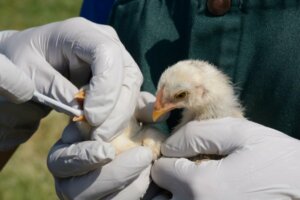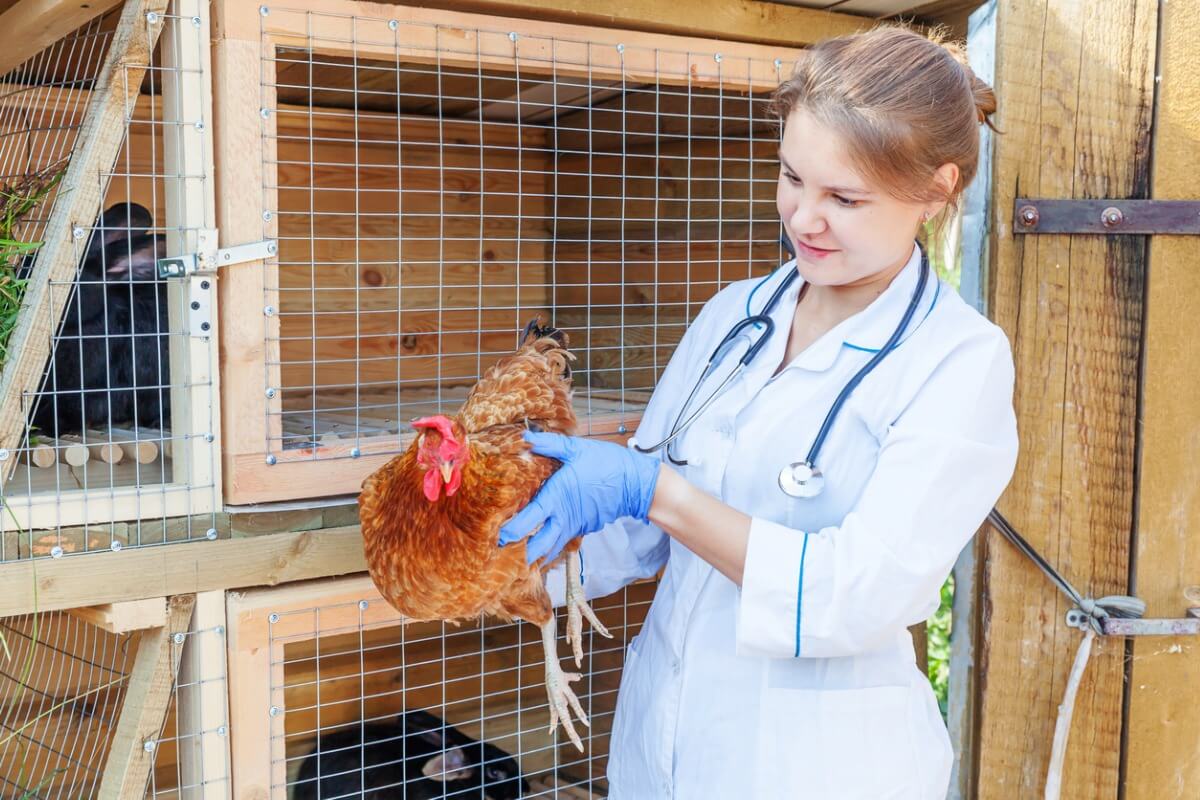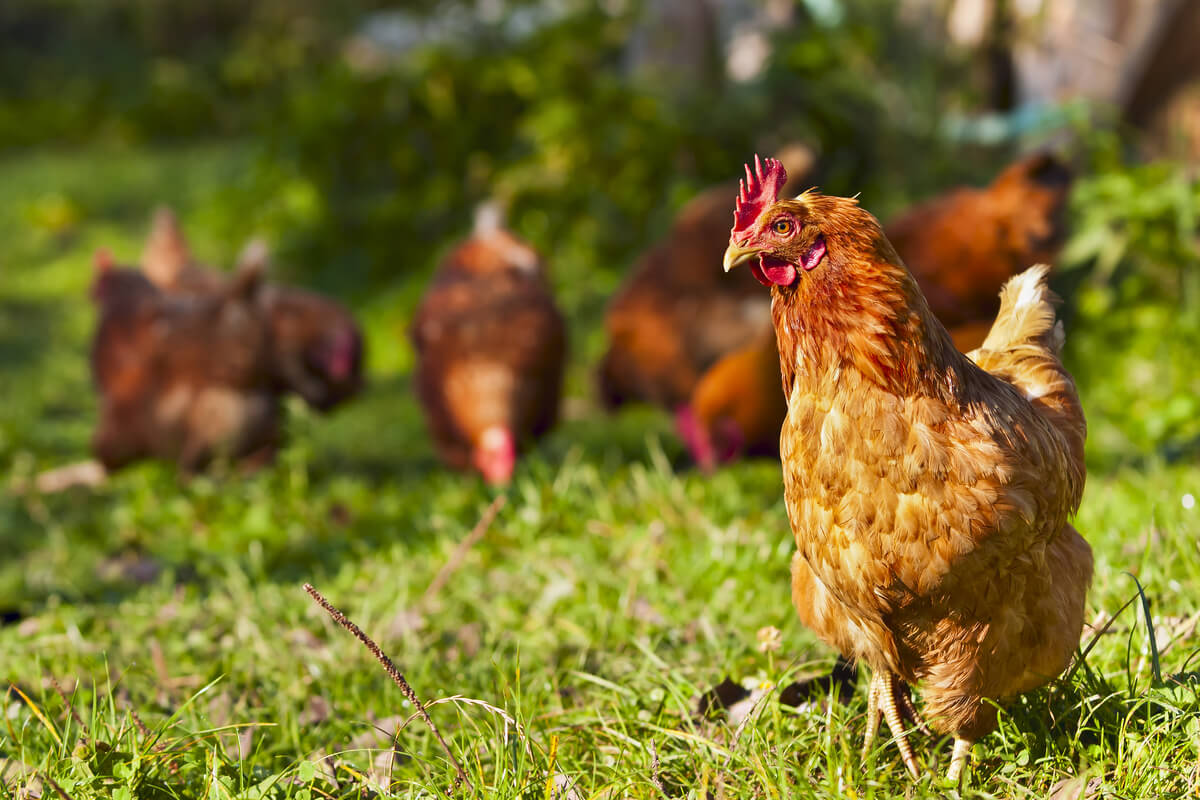Avian Infectious Bronchitis: Symptoms and Treatment

Avian infectious bronchitis is one of the most common diseases in free-range birds, such as chickens, although the virus is capable of affecting more species. Since its discovery in 1930, it hasn’t yet been eradicated from places where birds are crowded together, such as massive farms for the production of meat and eggs.
If you have birds and you suspect that the respiratory symptoms they’re suffering from are linked to this disease, don’t delay in going to the vet. In the meantime, learn a bit more about the characteristics, symptoms, and treatments that exist today.
What is avian infectious bronchitis?
Avian infectious bronchitis is an acute and highly contagious viral disease. The virus that causes it belongs to the genus Coronavirus and the order Nidovirales. Although it’s associated with the respiratory tract, the pathogen also replicates in the digestive system and even in the reproductive system.
The incubation period of the virus is about 10-14 days, which is the time it takes for the first symptoms to appear.
This infectious condition mainly affects ground birds such as chickens, turkeys, quails and partridges. It doesn’t matter how old the animal is, as cases have been reported in all stages of life. In addition, it can also wreak havoc on the kidneys, ovaries and affect the development of chicks (if they survive).

Causes of transmission
The main route of transmission is aerosols (droplets spread through the air by coughing and sneezing) and contact with the feces of infected animals. Infections are disproportionately promoted in places where several animals live together. It spreads rapidly and the mortality rate is high.
Avian infectious bronchitis is present all over the world and there are several serotypes specific to each region, such as the QX strain (China), the Massachusetts or Italy 02, also found in Spain.
Avian infectious bronchitis isn’t zoonotic, i.e. it can’t be transmitted to humans. It affects only birds and not all species. However, it’s advisable to disinfect areas where the virus has been found for safety, as secondary bacterial infections are common.
Symptoms of avian infectious bronchitis
As mentioned above, the symptoms of this disease aren’t limited to the respiratory system, and attack more organs, affecting their functions. The most representative clinical signs are as follows:
- A cough
- A runny nose and eye discharge
- Sneezing
- Difficulty breathing (the bird opens its beak or makes breathing noises)
- Birds flocking to heat sources
- Watery droppings
- Increased water consumption
- Abnormal egg-laying (eggs without shells, deformed, etc.)
- Lethargy
Some of these symptoms are compatible with other diseases typical of birds, such as cholera or smallpox. That’s why you should go to the vet immediately, especially when you live with more than one bird.
Diagnosis
For a reliable diagnosis, it isn’t enough to just observe the symptoms, as it’s necessary to isolate the virus through serological tests in order to identify it. Some of them are the following:
- ELISA test: This test detects antibodies created against the avian infectious bronchitis virus in the blood serum.
- RT-PCR: The polymerase chain reaction gives fairly reliable results in isolating the virus and identifying it, but it’s an expensive test.
- Hemagglutination inhibition (HI): to determine serotypes.
- Immunofluorescence assays
- Virus neutralization
- Immunohistochemistry techniques
- Electron microscopy
- Monoclonal antibodies
Except for the first two, which are the most used, the rest are accessory tests to refine the diagnosis of different strains. Often, this identification is of great help for treatment.
Treatment of avian infectious bronchitis
There’s no specific treatment for avian infectious bronchitis, but this approach is used to palliate the symptoms. For example, increasing the temperature in the house seems to reduce mortality. It’s also recommended to reduce the amount of protein provided in the diet and to add electrolytes to the water in order to prevent metabolic imbalances.
On the other hand, antibiotics are almost always prescribed as they help in the control of opportunistic infections that appear during the illness. This reduces the likelihood of the affected bird dying.
Prevention
Prevention and control of this disease is carried out through vaccination. There are live vaccines (with an attenuated virus) or inactivated vaccines, depending on the pathogenic strain to be treated and the bird population in question.
The issue of vaccination is complex, because while some vaccines control more than one strain, for other serotypes there’s none. This is why virus identification is so necessary: in many cases, a dose could be administered that doesn’t protect the animal adequately.

You’ll need to isolate infected birds as they appear. The mortality caused by avian infectious bronchitis is high, so the only thing left to do is to palliate the symptoms and hope that the animal will overcome the disease. Always disinfect thoroughly all areas and the animal housing, otherwise the virus will never disappear from the environment.
Avian infectious bronchitis is one of the most common diseases in free-range birds, such as chickens, although the virus is capable of affecting more species. Since its discovery in 1930, it hasn’t yet been eradicated from places where birds are crowded together, such as massive farms for the production of meat and eggs.
If you have birds and you suspect that the respiratory symptoms they’re suffering from are linked to this disease, don’t delay in going to the vet. In the meantime, learn a bit more about the characteristics, symptoms, and treatments that exist today.
What is avian infectious bronchitis?
Avian infectious bronchitis is an acute and highly contagious viral disease. The virus that causes it belongs to the genus Coronavirus and the order Nidovirales. Although it’s associated with the respiratory tract, the pathogen also replicates in the digestive system and even in the reproductive system.
The incubation period of the virus is about 10-14 days, which is the time it takes for the first symptoms to appear.
This infectious condition mainly affects ground birds such as chickens, turkeys, quails and partridges. It doesn’t matter how old the animal is, as cases have been reported in all stages of life. In addition, it can also wreak havoc on the kidneys, ovaries and affect the development of chicks (if they survive).

Causes of transmission
The main route of transmission is aerosols (droplets spread through the air by coughing and sneezing) and contact with the feces of infected animals. Infections are disproportionately promoted in places where several animals live together. It spreads rapidly and the mortality rate is high.
Avian infectious bronchitis is present all over the world and there are several serotypes specific to each region, such as the QX strain (China), the Massachusetts or Italy 02, also found in Spain.
Avian infectious bronchitis isn’t zoonotic, i.e. it can’t be transmitted to humans. It affects only birds and not all species. However, it’s advisable to disinfect areas where the virus has been found for safety, as secondary bacterial infections are common.
Symptoms of avian infectious bronchitis
As mentioned above, the symptoms of this disease aren’t limited to the respiratory system, and attack more organs, affecting their functions. The most representative clinical signs are as follows:
- A cough
- A runny nose and eye discharge
- Sneezing
- Difficulty breathing (the bird opens its beak or makes breathing noises)
- Birds flocking to heat sources
- Watery droppings
- Increased water consumption
- Abnormal egg-laying (eggs without shells, deformed, etc.)
- Lethargy
Some of these symptoms are compatible with other diseases typical of birds, such as cholera or smallpox. That’s why you should go to the vet immediately, especially when you live with more than one bird.
Diagnosis
For a reliable diagnosis, it isn’t enough to just observe the symptoms, as it’s necessary to isolate the virus through serological tests in order to identify it. Some of them are the following:
- ELISA test: This test detects antibodies created against the avian infectious bronchitis virus in the blood serum.
- RT-PCR: The polymerase chain reaction gives fairly reliable results in isolating the virus and identifying it, but it’s an expensive test.
- Hemagglutination inhibition (HI): to determine serotypes.
- Immunofluorescence assays
- Virus neutralization
- Immunohistochemistry techniques
- Electron microscopy
- Monoclonal antibodies
Except for the first two, which are the most used, the rest are accessory tests to refine the diagnosis of different strains. Often, this identification is of great help for treatment.
Treatment of avian infectious bronchitis
There’s no specific treatment for avian infectious bronchitis, but this approach is used to palliate the symptoms. For example, increasing the temperature in the house seems to reduce mortality. It’s also recommended to reduce the amount of protein provided in the diet and to add electrolytes to the water in order to prevent metabolic imbalances.
On the other hand, antibiotics are almost always prescribed as they help in the control of opportunistic infections that appear during the illness. This reduces the likelihood of the affected bird dying.
Prevention
Prevention and control of this disease is carried out through vaccination. There are live vaccines (with an attenuated virus) or inactivated vaccines, depending on the pathogenic strain to be treated and the bird population in question.
The issue of vaccination is complex, because while some vaccines control more than one strain, for other serotypes there’s none. This is why virus identification is so necessary: in many cases, a dose could be administered that doesn’t protect the animal adequately.

You’ll need to isolate infected birds as they appear. The mortality caused by avian infectious bronchitis is high, so the only thing left to do is to palliate the symptoms and hope that the animal will overcome the disease. Always disinfect thoroughly all areas and the animal housing, otherwise the virus will never disappear from the environment.
All cited sources were thoroughly reviewed by our team to ensure their quality, reliability, currency, and validity. The bibliography of this article was considered reliable and of academic or scientific accuracy.
- Beiras, A. M. A. (2010). Bronquitis infecciosa aviar: diagnóstico y control. REDVET. Revista electrónica de Veterinaria, 11(3), 1-23.
- Argoti, G. C., Alfonso, V. J. V., Jaime, J. C., & Nieto, G. C. R. (2015). Comportamiento del virus de la bronquitis infecciosa aviar en aves con sintomatología respiratoria provenientes de granjas de producción del Departamento de Cundinamarca. Nova, 13(23).
- Lopez, J. C., Mcfarlane, R., & Ulloa, J. (2006). Detección y caracterización del virus de bronquitis infecciosa aviaria en Chile mediante RT-PCR y análisis secuencial. Archivos de medicina veterinaria, 38(2), 175-178.
This text is provided for informational purposes only and does not replace consultation with a professional. If in doubt, consult your specialist.








